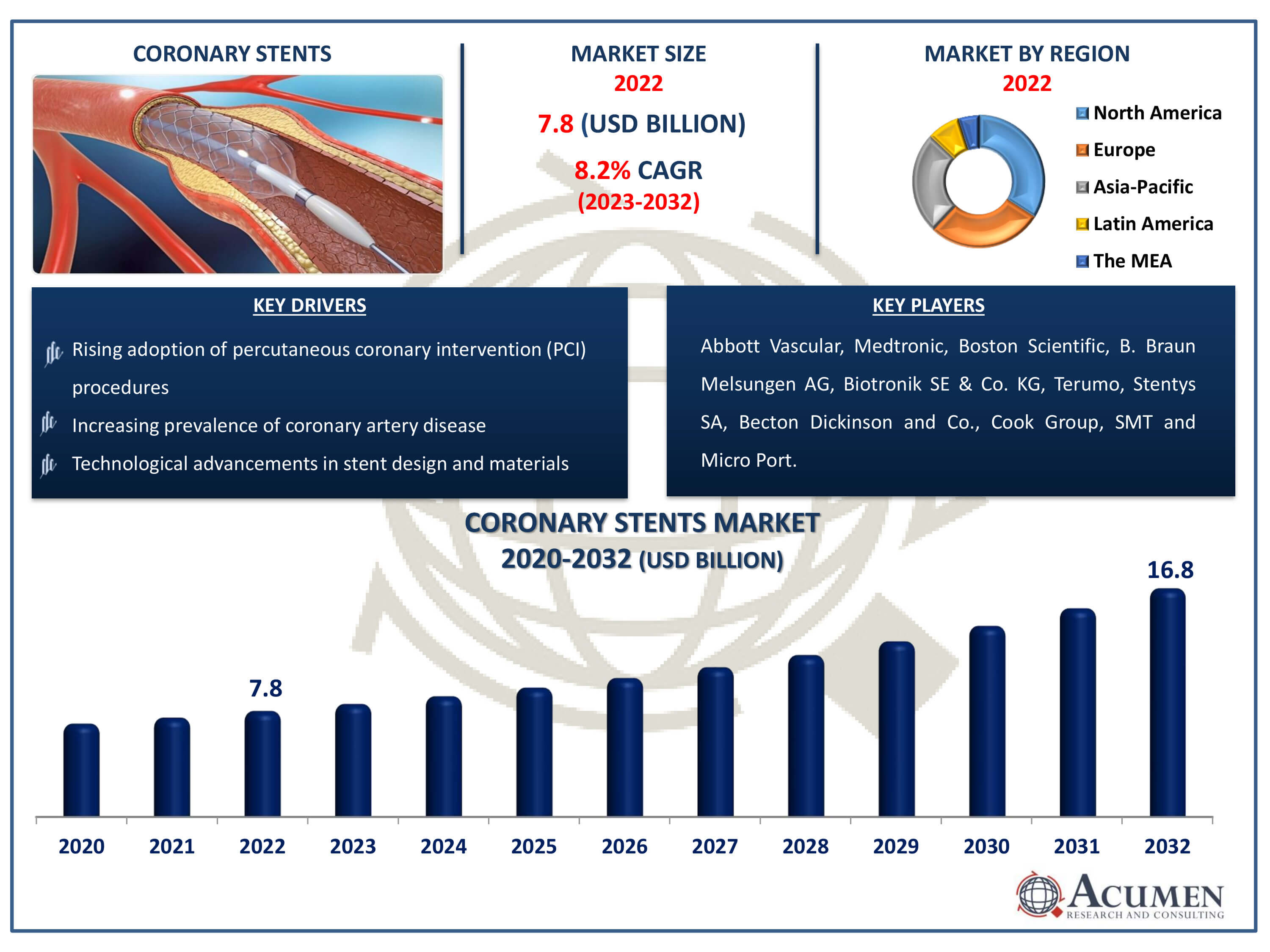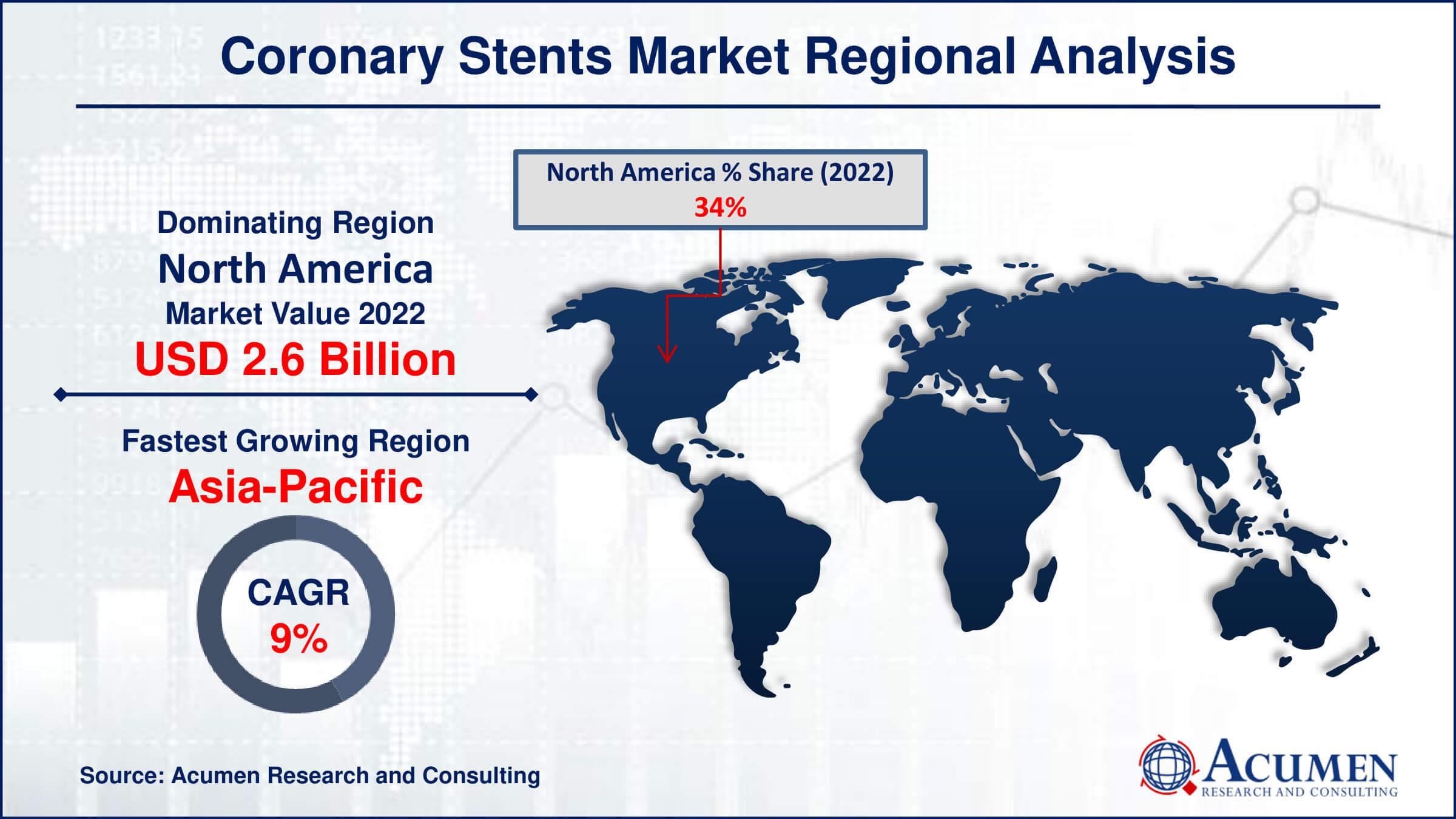May 2023
Coronary Stents Market Size accounted for USD 7.8 Billion in 2022 and is estimated to achieve a market size of USD 16.8 Billion by 2032 growing at a CAGR of 8.2% from 2023 to 2032.
The Coronary Stents Market Size accounted for USD 7.8 Billion in 2022 and is estimated to achieve a market size of USD 16.8 Billion by 2032 growing at a CAGR of 8.2% from 2023 to 2032.
Coronary Stents Market Highlights

A stent is a small, elastic tube-like mesh made from materials such as cobalt alloy or stainless steel. During stent implantation, a small balloon is used to open the stent inside the artery, providing support to the vessel wall and restoring blood flow. Stenting does not involve major incisions compared to coronary artery bypass surgery, making patients more comfortable with this procedure and driving the market for coronary stents. Coronary stents are used in a procedure called percutaneous coronary intervention (PCI), which accounts for more than 90% of PCI procedures, according to recent studies. Stents are primarily used to reduce angina (chest pain) and have been shown to improve durability and decrease adverse events in acute myocardial infarction. Treatment for coronary heart disease includes balloon angioplasty, pharmaceuticals, and coronary artery bypass grafting (CABG). Coronary stents also pose lower complications and health risks to patients post-surgery and have shown better recovery outcomes compared to coronary bypass surgery.
Global Coronary Stents Market Dynamics
Market Drivers
Market Restraints
Market Opportunities
Coronary Stents Market Report Coverage
| Market | Coronary Stents Market |
| Coronary Stents Market Size 2022 | USD 7.8 Billion |
| Coronary Stents Market Forecast 2032 | USD 16.8 Billion |
| Coronary Stents Market CAGR During 2023 - 2032 | 8.2% |
| Coronary Stents Market Analysis Period | 2020 - 2032 |
| Coronary Stents Market Base Year |
2022 |
| Coronary Stents Market Forecast Data | 2023 - 2032 |
| Segments Covered | By Type, By Biomaterial, By Mode of Delivery, By End User, And By Geography |
| Regional Scope | North America, Europe, Asia Pacific, Latin America, and Middle East & Africa |
| Key Companies Profiled | Abbott Vascular, Medtronic, Boston Scientific, B. Braun Melsungen AG, Biotronik SE & Co. KG, Terumo, Stentys SA, Becton Dickinson and Co., Cook Group, SMT, and Micro Port. |
| Report Coverage |
Market Trends, Drivers, Restraints, Competitive Analysis, Player Profiling, Covid-19 Analysis, Regulation Analysis |
Coronary Stents Market Insights
The alarming rise in the prevalence of cardiovascular diseases globally is a key factor driving the growth of the coronary stents market. According to the American Heart Association (AHA), cardiovascular diseases claim more lives each year than cancer and chronic lower respiratory diseases combined. Coronary heart disease ranks as the leading cause of mortality in the U.S., followed by stroke, heart failure, hypertension, and other diseases. Other factors driving the market include developing health infrastructure, lifestyle diseases, an increasing geriatric population, a profound increase in healthcare spending and coverage, the subsequent growth in the number of percutaneous coronary intervention (PCI) procedures, advancements in medical technologies and procedures, a full-fledged demographic shift toward an aging society, and the development of information and communication technologies (ICT). Growing government funding and investment in research and development for efficient and effective stents will boost the demand for coronary stents during the forecast period. Favorable reimbursement policies have been shown to increase the adoption of coronary stents in countries such as the U.S., Canada, India, and the U.K. For instance, the government in India subsidized the prices of drug-eluting and bare metal stents to drive their adoption in the country.
However, there are a few complications post-implementation of stents, such as blood clots and infections at the stent sites. Blood clots and blockages are the most common, which can be prevented by medications such as aspirin and anti-platelets. Thus, there is a constant need for novel and innovative advancements in the market. Some areas of improvement include the accuracy of the stents, enhancement in workflow and procedures, and reduction in errors. The development of biodegradable polymer stents, bioresorbable stents, scaffolds, and the facilitation of minimally invasive procedures are trends that will drive the market for coronary stents during the coronary stents industry forecast period.
Coronary Stents Market Segmentation
The worldwide market for coronary stents is split based on type, biomaterial, mode of delivery, end user, and geography.
Coronary Stent Types
According to coronary stents industry analysis, among all types, both bare metal and drug-eluting stents (DES) are extensively adopted by patients and preferred by healthcare practitioners. Currently, drug-eluting stents hold the largest share in the global coronary stents market, as they are considered the gold standard treatment and are expected to continue exhibiting strong growth during the forecast period. Drug-eluting stents hold 80% of the market and are promoted by many healthcare professionals due to their efficacy and benefits over other procedures. Moreover, with technological progress, these stents have improved and shown additional reductions in stent thrombosis. Using DES in stenting offers improved outcomes for patients with coronary artery disease (CAD) treated with percutaneous coronary intervention (PCI). Bio-absorbable stents are projected to grow at an exponential rate during the forecast period. Bio-absorbable or bioresorbable stents were introduced as an alternative due to growing concerns about the presence of stents for a lifetime or until surgically removed. New product approvals and their benefits will surge the demand for these stents in the global coronary stents market.
Coronary Stent Biomaterials
Metallic biomaterials constitute the largest sector in the coronary stent market. Cobalt-chromium and stainless steel are two examples of metallic biomaterials that are frequently used in the production of coronary stents because of their superior mechanical qualities and extensive durability. With their exceptional strength and flexibility, these materials give the blood vessel walls the best support possible while preserving the integrity of the stent. In addition, medical professionals favour metallic stents due to their dependability and effectiveness in treating coronary artery disease, as well as their demonstrated track record of clinical success. Therefore, the market for coronary stents is dominated by the metallic biomaterial category.
Coronary Stent Mode of Deliveries
The balloon-expandable stent category expected to holds the highest share in the coronary stent market. Because of their precise deployment capabilities and adaptability, balloon-expandable stents are commonly used. A balloon catheter is used to deliver these stents to the intended location, where they are expanded and fixed firmly inside the coronary artery. Stents that are balloon-expandable provide consistent and regulated expansion, which promotes ideal vascular scaffolding and reduces the possibility of stent malapposition. Because of their dependability and efficiency in treating coronary artery disease, balloon-expandable stents are the most favoured type of coronary stents among medical professionals.
Coronary Stents End User
Hospitals are the biggest end-user group in the coronary stent industry. Hospitals are the main healthcare facilities that are furnished with specialised equipment and highly qualified medical staff to carry out intricate operations, such as the placement of coronary stents. Many patients in need of cardiac procedures are drawn to hospitals due to their extensive array of services and resources. Hospitals further solidify their position as major users of coronary stents by accepting patients from a variety of healthcare settings through their well-established referral networks. In addition, hospitals guarantee the best possible outcomes for their patients by offering post-procedural care and ongoing monitoring. Hospitals make up the largest section of the coronary stents market due to their widespread use in the healthcare system and versatility in treating a variety of medical ailments.
Coronary Stents Market Regional Outlook
North America
Europe
Asia-Pacific
Latin America
The Middle East & Africa

Coronary Stents Market Regional Analysis
The market experienced high demand in the North American region in 2022 and is anticipated to dominate the market during the coronary stents market forecasted period. According to the Stroke Association, approximately 1 million Americans are affected by strokes each year. Solely in the U.S., the financial burden of strokes is valued at $34 billion annually, including expenditures on healthcare services, prescriptions, and reduced productivity. The American Stroke Association (ASA) has made great efforts to transform existing healthcare systems and support patients worldwide by collaborating with other countries, governments, and international cardiac societies. Countries in this region have well-established healthcare systems, well-planned compensation programs, and a rise in population numbers, all of which contribute significantly to the global coronary stent market. The latest developments in bio-absorbable stents and the growing popularity of new trends have been observed in this region.
In terms of coronary stents market analysis, Asia-Pacific is the second largest and fastest growing region compared to others. China, with its large population, leads the Asia-Pacific market for coronary stents. Stroke is one of the leading causes of death in China, claiming 1.6 million lives annually. China experiences similar stroke risk factors as Western nations. Furthermore, China has identified specific geographic areas where the mortality associated with stroke is 50% higher than other regions in the country. Additionally, growing healthcare infrastructure and target populations in countries like India, Japan, and Indonesia will further drive the market. The growing medical tourism industry in the region will also generate demand for coronary stents. In China and India, the coronary stents market is increasing due to economic developments and government initiatives. For example, the comprehensive tax system and Goods and Services Tax (GST) in India prevent the cascading effect of taxes, benefiting both consumers and manufacturers by reducing taxes.
Coronary Stents Market Players
Some of the top coronary stents companies offered in our report includes Abbott Vascular, Medtronic, Boston Scientific, B. Braun Melsungen AG, Biotronik SE & Co. KG, Terumo, Stentys SA, Becton Dickinson and Co., Cook Group, SMT, and Micro Port.
Looking for discounts, bulk pricing, or custom solutions? Contact us today at sales@acumenresearchandconsulting.com
May 2023
April 2024
July 2021
June 2022